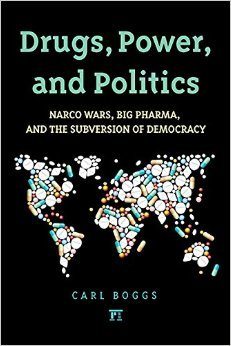The drug war is out of control. It is responsible, both directly and indirectly, for the massive rate of incarceration in the United States. It is also a direct cause of the increase in police harassment faced daily by tens of thousands of US residents, especially those of color. It is in large part responsible for the constant surveillance we live under and, even worse in some ways, for our casual acceptance of this surveillance and the abuses that come with it. Among these abuses one can include home invasions by overly-armed police, arrests via entrapment, drug sniffing dogs in schools, airports, and even at music festivals. Even this is not enough for some law enforcement officials. Newt Gingrich and New Jersey’s Governor Christie are but two of the more prominent politicians who consider the recent legalization of marijuana in Washington and Colorado (among others) to be criminal and wrong. Their statements remind one of former LAPD Chief Daryl Gates’ wish that all drug users should be shot.
Yet, the United States of America is home to the world’s most medicated population in history. The use of legal prescribed pharmaceutical drugs—many of them considerably more harmful than their illegal cousins—is at an all-time high. One can turn on the television at any time of the day or night and witness at least two or three glossy advertisements for some kind of pharmaceutical compound within the first twenty minutes of viewing. These advertisements include a laundry list of the potential dangers each one poses. Yet, law enforcement agencies like the Drug Enforcement Agencies (DEA) focus on the pursuit and arrest of marijuana growers, dispensaries, and sellers for reasons seemingly known only to them.
Author Carl Boggs takes this situation on in his most recent book, Drugs, Power, and Politics: Narco Wars, Big Pharma, and the Subversion of Democracy. One of the few such texts discussing the obvious hypocrisy of illegal drugs and the corporate pharmaceutical business, Drugs, Power, and Politics dissects the economics and politics of both sides of the drug business in twenty-first century United States. In doing so, the book also reveals the structural design that business serves as both metaphor and integral part of. The numbers he cites are representative of the role the current effort to control who takes drugs, what kind of drugs they take and who profits from them are staggering in themselves: 900,000 marijuana arrests in the United States from2002 to 2012, eighty percent of painkillers consumed are consumed by US residents, global sales of pharmaceutical drugs approximately $840 billion, DEA budget $3 billion. These are but the tip of the iceberg, but prove Boggs’ point that money is a primary factor in the seemingly endless narco wars.
Once one moves beyond the dollar signs and the arrest figures, other even more ominous phenomena appear. Perhaps foremost among them is the statistically obvious racism of the law enforcement aspect of the US war on drugs. Black and Latino residents (mostly young men) in the US are stopped, frisked, arrested and imprisoned at rates far beyond their relative percentage of the population in the country. Furthermore, the extremely long leash given to police officers and agents involved in illegal drug enforcement when added to the panopticon of surveillance that has been constructed to fight this trade makes the DEA a greater threat to civil and human rights than any other government agency in North America. When combined with the growing militarization of local police forces and an increasing use of drones, the level of surveillance becomes almost incomprehensible.
The symptoms of the desire to control drugs, who uses them, and which ones are to be legal are somewhat common knowledge. They are also disheartening and almost too numerous to list much less comprehend. Boggs utilizes these to discover and discuss the disease these symptoms represent. In his competent hand, that disease is easily recognized: neoliberal global capitalism. Both major political parties are part and parcel of this system, so there is no easy or obvious political way out of the hold Big Pharma and law enforcement have over our lives and well-being. The former uses its enormous wealth to write legislation in its favor while opposing other laws that might impinge on its profits; at the same time, it seduces the public with unfettered access to the airwaves and our wallets. Meanwhile, the regiments aligned against the illegal drug trade are now the most undemocratic realm of American public life.
Carl Boggs has written a comprehensive history useful to the drug war opponent and the civil libertarian. It is equally useable to the social scientist, the pot grower, the student looking for valid and well-researched information, and the interested citizen wondering what the hell is happening to their country. By placing the prevalent US drug control mechanisms into the capitalist economic model he provides an analysis that makes clear the role profits play in each and every facet of the drug economy, from pharmaceutical sales to the often brutal policing of illegal drug users in America’s streets.
Ron Jacobs is the author of a series of crime novels called The Seventies Series. All the Sinners, Saints, is the third novel in the series. He is also the author of The Way the Wind Blew: a History of the Weather Underground. He is a contributor to Hopeless: Barack Obama and the Politics of Illusion, published by AK Press. His book Daydream Sunset: Sixties Counterculture in the Seventies will be published by Counterpunch. He lives in Vermont. He can be reached at: ronj1955@gmail.com.